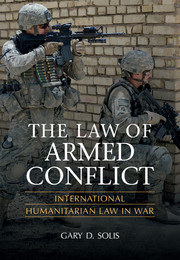Book contents
- Frontmatter
- Contents
- Table of Cases
- Table of Treaties
- Foreword
- Preface
- Acknowledgments
- LAW OF ARMED CONFLICT: INTERNATIONAL HUMANITARIAN LAW IN WAR
- LAW OF ARMED CONFLICT AND INTERNATIONAL HUMANITARIAN LAW: A FRAMEWORK
- LAW OF ARMED CONFLICT AND INTERNATIONAL HUMANITARIAN LAW: BATTLEFIELD ISSUES
- 9 Obedience to Orders, the First Defense
- 10 Command Responsibility and Respondeat Superior
- 11 Ruses and Perfidy
- 12 Torture
- 13 Rules of Engagement
- 14 Targeting
- 15 Attacks on Cultural Property
- 16 The 1980 Certain Conventional Weapons Convention
- 17 Gas, Biological, and Chemical Weapons Treaties
- References
- Index
- References
15 - Attacks on Cultural Property
from LAW OF ARMED CONFLICT AND INTERNATIONAL HUMANITARIAN LAW: BATTLEFIELD ISSUES
- Frontmatter
- Contents
- Table of Cases
- Table of Treaties
- Foreword
- Preface
- Acknowledgments
- LAW OF ARMED CONFLICT: INTERNATIONAL HUMANITARIAN LAW IN WAR
- LAW OF ARMED CONFLICT AND INTERNATIONAL HUMANITARIAN LAW: A FRAMEWORK
- LAW OF ARMED CONFLICT AND INTERNATIONAL HUMANITARIAN LAW: BATTLEFIELD ISSUES
- 9 Obedience to Orders, the First Defense
- 10 Command Responsibility and Respondeat Superior
- 11 Ruses and Perfidy
- 12 Torture
- 13 Rules of Engagement
- 14 Targeting
- 15 Attacks on Cultural Property
- 16 The 1980 Certain Conventional Weapons Convention
- 17 Gas, Biological, and Chemical Weapons Treaties
- References
- Index
- References
Summary
Introduction
We have discussed how law of armed conflict/international humanitarian law (LOAC/ IHL) consists, at least, of 1907 Hague Regulation IV, the 1949 Geneva Conventions, the 1977 Additional Protocols, customary international law, case law, and multinational treaties. In fact, there are scores, perhaps hundreds, of treaties, conventions, declarations, compacts, and resolutions that bear on LOAC/IHL in one way or another.
Six multinational treaties are particularly significant to LOAC/IHL: the 1925 Gas Protocol Prohibiting the Use in War of Asphyxiating, Poisonous or Other Gases; the 1954 Hague Convention for the Protection of Cultural Property; the 1971 Convention on the Prohibition of Development, Production and Stockpiling of Biological and Toxin Weapons; the 1997 Ottawa Treaty Banning the Use, Stockpiling, Production and Transfer of Anti-Personnel Land Mines; the 1980 Convention on Certain Conventional Weapons; and the 1993 Convention on the Prohibition of Development, Production, Stockpiling and Use of Chemical Weapons. The 1976 Convention on Environmental Modification might reasonably be added to that list.
Of these, the 1980 Conventional Weapons and 1993 Chemical Weapons Conventions, particularly, have potential impact on warfighters. Violations of either, could lead to war crime charges against combatants in the field or, at the least, intensly negative international scrutiny. In this chapter, the 1954 Hague Convention for the Protection of Cultural Property in the Event of Armed Conflict, and its two Protocols, also receive attention. It is essentially a treaty about targeting.
- Type
- Chapter
- Information
- The Law of Armed ConflictInternational Humanitarian Law in War, pp. 556 - 576Publisher: Cambridge University PressPrint publication year: 2010



